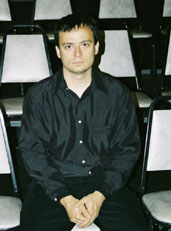
Rusty Banks is a composer/guitarist/teacher originally from Jasper, AL, now living in Pennsylvania.
His compositions benefit from themes relating to regions or environments. For example, his composition commissioned by the Alabama Music Teacher Association's 2004 convention featured audio samples from the Cahaba River, Alabama's last free-flowing river. Another work, "Long Pine Creek: New Year's Day," uses sounds from Long Pine Creek in Nebraska. His compositions range from traditional concert music to sonic installations where boom boxes are scattered throughout a room. His music is described as thoroughly modern, yet accessible, a description he shudders at, but reluctantly accepts. His compositions may be heard on Living Artist Recordings, as well as his web site, rustybanks.org.
|

Friday, July 10, 2009
Heterophony
In one of my theory classes as an undergrad, my comp teacher noted that the prevalent interval classes had, for the most part, evolved along the path of the overtone series: chant (octaves), organum (fifths), common practice (thirds) early 20th century (seconds) later 20th century (microtones). So what was next, he asked with a smile.
I thought unison would be a dreadfully boring place to go, but then, Reich and Andriessen were doing things with imitation at the unison that was pretty exciting. There was also the idea of heterophony. While very common in non-western music, and even some western folk traditions, heterophony is only touched on occasionally by modern composers, and more as a decorative orchestration technique than a substantive idea in a piece.
One of my first successes with a more formal approach to heterophony is a movement from Taxonomy for flute and clarinet. The movement, Elaphe, evokes the genus of snakes it is named for by presenting patterns then blurring them (the main, if pitiful, defense ratsnakes have against predators). A pattern is presented in the clarinet, and the flute grabs on to certain notes, making it seem that the clarinet has left ghosts, or echoes, or is anticipated. While a bit more complex than doubling the melody with some ornamentation, it has a similar “thickening” effect that heterophony does in the music of Ireland or Thailand. One difference, however, is that in traditional heterophony the rhythmic edges are softened, whereas in this style they become more angular.
You can see the score and listen to the effect.
Betsy Bobenhouse, Flute; Christy Banks, clarinet.Labels: composing, heterophony, Rusty Banks, snakes, taxonomy
posted by Rusty Banks
Friday, March 13, 2009
Sexxxy Tuba
Here's a test mix for my latest commission; a tuba, electronics and boomboxes piece called 2ba4. The work starts much more sparsely with little sounds moving around the audience. By the end, it builds to this little jam.
The work was commissioned by tubist Matt Brown, who is a total mofo on the iron bass. It premieres April 5, 2009 as part of the Millersville University Tuba/Euphonium Symposium.Labels: 2ba4, funk, iron bass, matt brown, Rusty Banks, Tuba
posted by Rusty Banks
Monday, November 19, 2007
Word from China

Ah. Such a nice email to receive. The Continental Trombone Quartet is quickly becoming a force in New Music. They’ve already commissioned 13 new works for the ensemble, with many more in the making. I wrote them a short flashy piece for their performance in Beijing. The work in called “Bone Jump” and is a post-minimal reworking of fragments of pop tunes that have the word “jump” in the title.
We are currently working on a work for trombone quartet, SATB choir, electronics, video, and dance. More on that later…
Rusty,
Back from China and happy to report a fine performance of your well received composition. I do not know if we will receive a recording or not, that was unclear. The guys loved working on your piece and plan to continue to perform it on a regular basis.
Thanks so much for the great composition. Please be in contact with Doug, copied here, about publishing under the CTQ Series with PebbleHill Publishers.
Talk soon.
Mark
Labels: Bone Jump, China, Rusty Banks, trombone, trombone quartet
posted by Rusty Banks
|
| |



